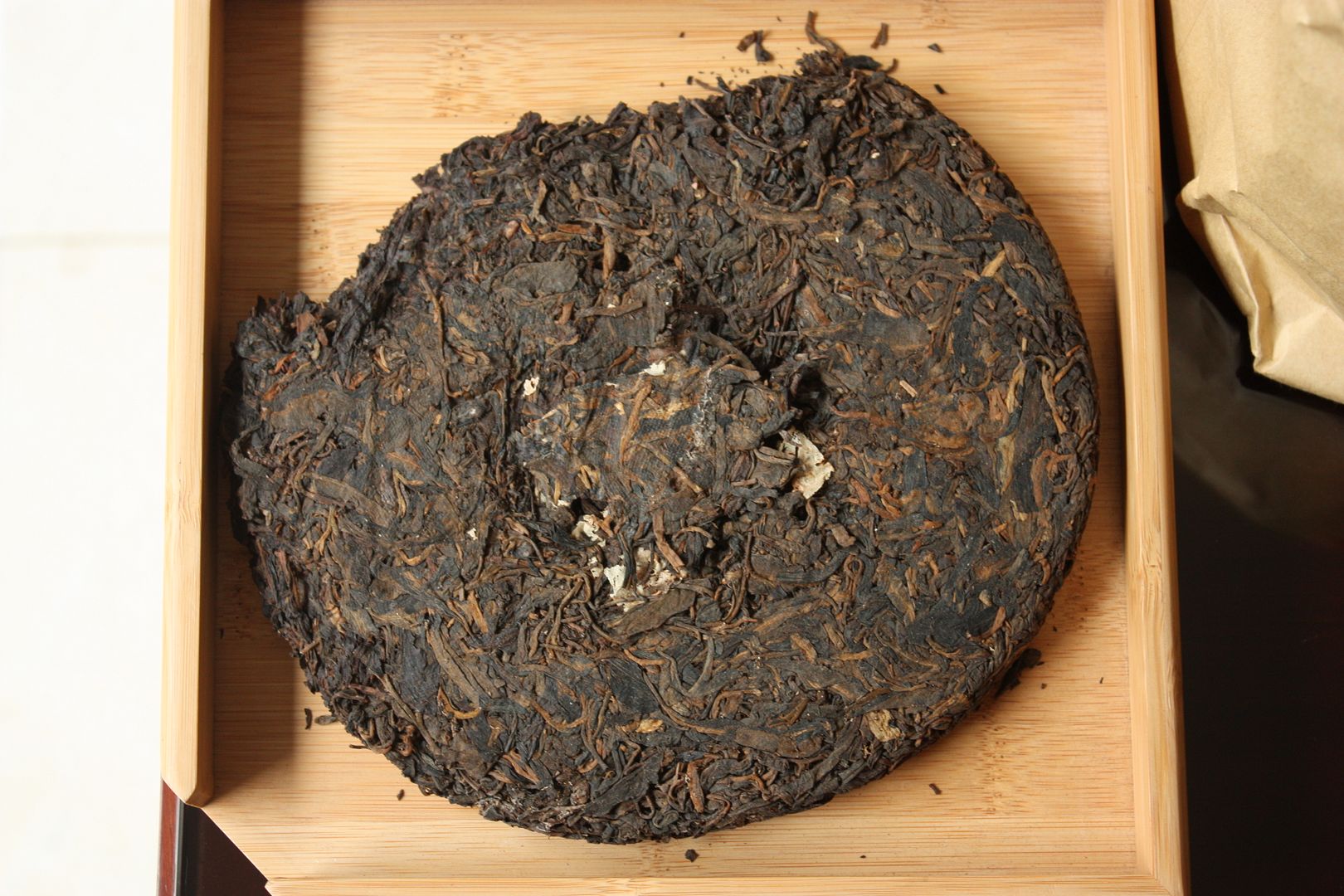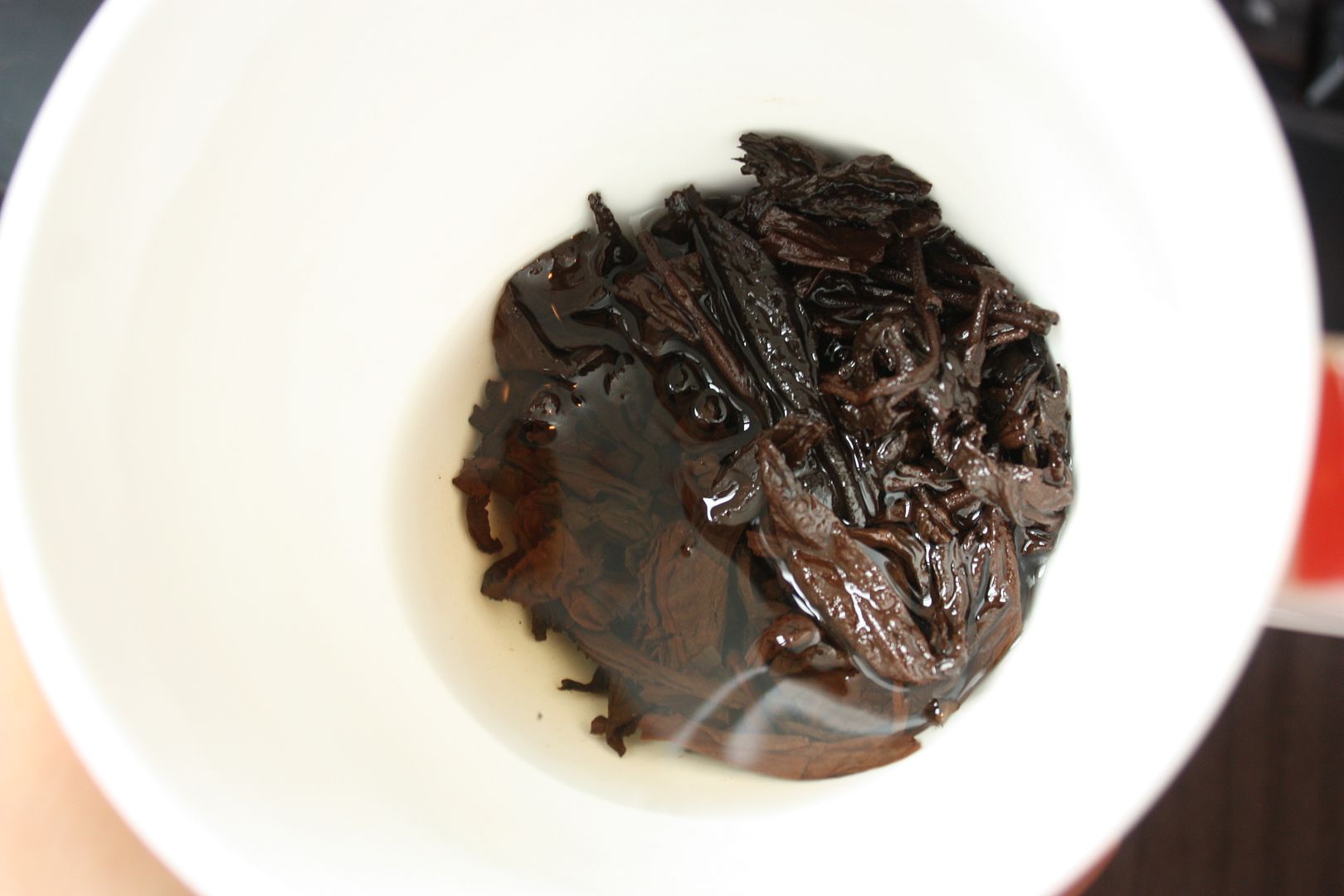The best and the rarest teas that you’re ever going to drink is most likely to come by serendipity, unless, of course, a few hundred thousand dollars to you is spare change that can be blown on tea. For those of us not in the 0.05%, that’s not really an option.
Thankfully, these chances to drink nice tea come more often than you think, especially if you hang out with the right people and get to tag along when someone with a lot of tea happens to invite you over. Or, you can get lucky.
During a recent visit to a friend’s place I was given a 3/4 of a puerh cake to examine. I was told that this was given to them by one of their moms, ostensibly for stomach issues. The cake looks like this
The center is loose because I had to pry it open to see the neifei. Unfortunately, the neifei decided to stick to the surface leaves that I pried open, instead of sticking to the leaves underneath. Either way:
And closeups
And the back
When I saw the cake, I thought this is something very old. There are traces of a bigger ticket on the surface of the cake that fell off. Everything about the cake, from the type of neifei to the leaves to everything, suggests to me that this is something quite old. I was tasked with taking it home and trying to determine what it is.
There doesn’t seem to be much of a back story for this tea, other than that this is a cake from a family that’s been in the US for decades, and that some member of the family (the grandfather, I think?) was a customs officer in Yunnan before the war. Ok, sounds good.
Now, I do not profess to be an expert in antique-era cakes, namely cakes produced prior to the nationalization of the tea firms post 1949. I’ve had somewhere between half a dozen to a dozen examples of these things, at various places in various conditions. Prices for these things these days are astronomical – a full cake, retail, would probably set you back about $100,000 USD. That’s not a cheap tea, and one brew will easily cost $1000 or more. These are not teas that mere mortals drink, not on a regular basis anyway. They also do not offer the greatest bang for the buck. But, you try them because they are what they are – rare teas that offer a glimpse to the past, because they offer unique tastes and qi that other teas simply do not possess. So many things have to happen for these teas to survive – and chances are, many of these aren’t even the best examples of teas, because the best ones have long been consumed. So, take it for what it’s worth.
It is in that spirit that I tried this tea. After all, I had no firm idea what it is. Searching around, I think the very faded neifei looks very much like the horizontal ones used by Tongqing hao, with the few characters that I can make out and the border decoration. The tea brews dark, very dark, like they are supposed to.
The taste is very hard to describe – the first few infusions have a very strong, unique taste that I find to be common among these very old teas. It’s smooth, and full bodied. The tea is still very slightly bitter, with a clear cooling sensation down the throat. The qi is strong, soothing, and obvious. Very often you see people bandy about qi as if every tea has it – well, not really. This is what you’re looking for when you drink a tea for qi, and when someone tells you that the 10 years old cooked puerh they were drinking has qi, well, please take it with a grain of salt. This is what good, strong qi should be. There’s no faking it.
It’s really rather luxurious drinking this tea by myself. The only other time I had an antique tea mostly for myself was when I had Tongqing at Wisteria, but there their tea was loosened up years before, so the qi and the taste were both less immediate. This tea, for some reason, is slightly more compact than other antique teas I’ve seen – possibly because it’s never changed hands in the past decades and has been stored in a drier environment than Southern China. The leaves are very brittle, and break on command. In retrospect, I probably should’ve been more careful peeling the leaves away to check the neifei, but at that time, I had no idea what this was.
Teas like this fade quite quickly – within about ten infusions the initially intense taste will die down, but what replaces it is a very consistent tea that lasts much longer, with the same throatiness and soothing sensation. In some ways, I think these antique teas have gone over the hill a bit – they are not as strong as, say, a Red Label. On the other hand, there’s a soothing calmness to these antique teas that make them very attractive. Twenty or thirty infusions later, when the taste from each individual infusion becomes very weak, I grandpa’ed a few more cups of the tea, which also allows for good shots of the wet leaves. You can see the tea is still brown, not black, and the leaves are not stiff or carbonized in any way – they’re still very flexible. Also, unlike cooked puerh, they retain their shape and consistency when lightly rubbed.
And finally, you can boil these things. Boiling old teas will yield a strong jujube taste, but once you do it, the tea is spent and there’s nothing left to do with it other than send it to the garbage bin or the compost pile.
Two kettles later, I called it quits. I think I wrung everything there is to wring out of these leaves. Is it great tea? Yes, maybe, depending on your perspective. It’s not as exciting as an oolong or a newer puerh. It’s not as impressive as a 30 years old puerh. It’s not as fragrant as a green tea. It does, however, possess an old man’s quality to it – it has depth and strength. This is also probably the most potent of the antique teas I’ve had – again, might have to do with its storage conditions in the United States, rather than Southern China. Having said that, it’s not a tea you’d drink every day, or even every month. It’s also not a tea you buy to drink, unless you have too much money to burn. For the approximately five grams I had, this tea cost somewhere in the vicinity of 1200-1500 USD. In other words, it’s worth more than its weight in gold. Having tried it is already good enough.










 RSS - Posts
RSS - Posts
7 responses so far ↓
shah8 // July 25, 2012 at 11:21 am |
Is is wrong, pathetic, to say that I have lurid fantasies of discovering 70’s puerh inside an old armoir that I got at a yard sale?
MarshalN // July 25, 2012 at 9:31 pm |
Why not dream of 1920s tea instead? Dreams are free!
shah8 // July 26, 2012 at 1:17 am |
Yeah, but the best ones are slightly believable.
Su Ming Ng // July 25, 2012 at 8:12 pm |
Lucky you ! Once you develop a taste for these kind of teas you’re really done for cos you’d pay almost anything to have another taste of it . There’s nothing quite like the the elgance of an old old puer. If the tea has been kept in the open , it will be be mellow. To bring it back up again, put it in an airtight pewter tea caddy for a few months and drink it again. you’ll be amazed at the difference. the tea comes back to life !
Su
MarshalN // July 25, 2012 at 9:33 pm |
Well, odd though it may sound, I don’t think I’d want to drink this every day, even if I have an endless supply. Right now it’s stored in a round metal mooncake box, which is actually perfect – air tight, flat, no smells.
Brian S. Kirbis // May 3, 2013 at 3:36 am |
Great story! Am I mistaken or are there wrapper lines on the back of the cake? Highly unusual for teas of that era. A clue?
I’m sure you have many references, in the vein of Deng Shihai, for antique tea. However, if you can get a detailed image of the neifei, I’d love to have a go at it!
MarshalN // May 3, 2013 at 3:37 am |
Wrapper? No wrapper. Not in Deng Shihai either, or any other book, so it’s a mystery cake.